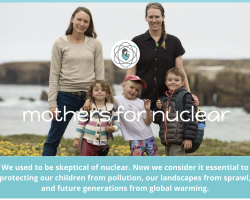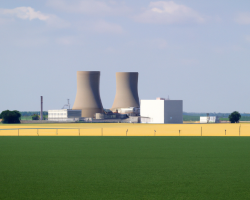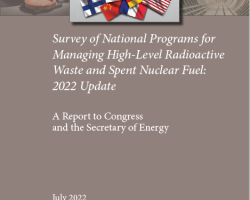Category of Content
Siting Experience Documents Only
Publication Date
Subject Matter
Public Preferences Related to Consent-Based Siting of Radioactive Waste Management Facilities for Storage and Disposal: Analyzing Variations over Time, Events, and Program Designs ?
Public Preferences Related to Consent-Based Siting of Radioactive Waste Management Facilities for Storage and Disposal: Analyzing Variations over Time, Events, and Program Designs ?
Verification and Validation Strategy for Implementation of Hybrid Potts-Phase Field Hydride Modeling Capability in MBM
Verification and Validation Strategy for Implementation of Hybrid Potts-Phase Field Hydride Modeling Capability in MBM
Public Views about Storage and Disposal Options for Spent Nuclear Fuel. Energy and Environment Survey, 2017
Public Views about Storage and Disposal Options for Spent Nuclear Fuel. Energy and Environment Survey, 2017
Effects of Radial Hydrides on PWR Cladding Ductility following Drying and Storage
Effects of Radial Hydrides on PWR Cladding Ductility following Drying and Storage
Preliminary Destructive Examination Results for Sibling Pin Cladding
Preliminary Destructive Examination Results for Sibling Pin Cladding
Modeling Hydride Reorientation in Cladding
Modeling Hydride Reorientation in Cladding
Preliminary Destructive Examination Results for Sibling Pin Cladding
Preliminary Destructive Examination Results for Sibling Pin Cladding
Mothers for Nuclear Flyer
Mothers for Nuclear Flyer
Mothers for Nuclear Informational Flyer
Interim Storage, Environmental Justice, and Generational Equity
Interim Storage, Environmental Justice, and Generational Equity
With the termination of the Yucca Mountain project, which was proposed to be our nation’s first repository for the disposal of military and civilian spent nuclear fuel and high-level radioactive waste, the future of nuclear waste management and disposal in this country became increasingly uncertain. Interim storage has been advocated by many as a temporary solution while a permanent solution is studied for potentially several more decades to come.
Intergenerational Ethical Issues and Communication Related to High-Level Nuclear Waste Repositories
Intergenerational Ethical Issues and Communication Related to High-Level Nuclear Waste Repositories
Purpose of Review: The nuclear power industry started in the 1950s and has now reached a phase of disposing high-level nuclear waste. Since the 1980s, the United Nations has developed a concept of sustainable development and governments have accordingly made ethical commitments to take responsibility towards future generations. The purpose of this review is to examine ethical dilemmas related to high-level nuclear waste disposal in a long-term perspective including potential access to the waste in the future.
Community Involvement Plan: Area IV, Santa Susana Field Laboratory
Community Involvement Plan: Area IV, Santa Susana Field Laboratory
As a result of the 2007 ruling by the U.S. District Court of Northern California that the DOE must prepare an Environmental Impact Statement (EIS) to evaluate alternatives for cleanup of Area IV of the SSFL, DOE has implemented major changes in its management of SSFL Area IV. As an initial step, this community involvement plan (CIP) outlines a series of activities and programs that intend to engage the public, establish transparency in DOE actions and decisions, and increase input from the community.
Topical Analysis of Nuclear Experts' Perceptions of Publics, Nuclear Energy, and Sustainable Futures
Topical Analysis of Nuclear Experts' Perceptions of Publics, Nuclear Energy, and Sustainable Futures
Nuclear energy experts consider commercial power from fission to be a strong contender to help mitigate the increasing effects of climate change, in part due to its low-to-no carbon emissions. Nevertheless, nuclear energy's history, including meltdowns such as Three Mile Island, Chernobyl, and Fukushima, and dumping in sacred Indigenous land such as Yucca Mountain, raises important concerns in public deliberation over nuclear power.
Nuclear power and the public: an update of collected research on nuclear power
Nuclear power and the public: an update of collected research on nuclear power
The purpose of this research was to collect, analyze, and summarize all of the nuclear power-related surveys conducted in the United States through June, 1981, that we could obtain. The surveys collected were national, statewide, and areawide in scope. Slightly over 100 surveys were collected for an earlier, similar effort carried out in 1977. About 130 new surveys were added to the earlier survey data. Thus, about 230 surveys were screened for inclusion in this report.
Science based responses to social myths on nuclear energy
Science based responses to social myths on nuclear energy
In order to promote a sound basis for considering the role of nuclear in climate change, this review spans the technical topics of social and political debate surrounding nuclear energy with a focus on the objective science of these issues including nuclear waste, accidents and overall risk. Novel aspects include the emergence of nuclear energy as being potentially renewable and the antithesis of Fukushima being an argument for the unacceptable risks associated with the use of nuclear energy.
Survey of National Programs for Managing High-Level Radioactive Waste and Spent Nuclear Fuel: 2022 Update
Survey of National Programs for Managing High-Level Radioactive Waste and Spent Nuclear Fuel: 2022 Update
In October 2009, the U.S. Nuclear Waste Technical Review Board (Board or NWTRB) published Survey of National Programs for Managing High-Level Radioactive Waste and Spent Nuclear Fuel. For each of the 13 national programs studied, the report catalogued 15 institutional arrangements that had been set in place and 15 technical approaches that had been taken to design repository systems for the long-term management of high-activity radioactive waste.



